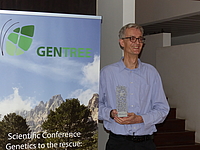Trees, like people, come in different sizes and present variants in the traits they have in common with other individuals of the same species. Every person and tree has a specific look or, in other words, a particular phenotype that results from the interaction between genetics and environment.
A recent study shows that the role of genetics in determining trait variability can be estimated in natural settings, using forest inventory data, rather than in common gardens only, as previously thought. It also shows that tree height is decreasing in warmer climates in response to recent anthropogenic climate warming. The findings can help save funds for common gardens and further improve prediction of growth performance of different tree provenances.
For trees, phenotypic traits are the fundamental drivers of community assembly and ecosystem functioning, determining how tree populations respond to climate change. Therefore, it is important to understand how they vary across the distribution range of a species.
Phenotypic traits are typically measured in common gardens, where individuals from various tree populations grow together under the same conditions. This enables to estimate the genetic component of their variability independently of the effects of the environment.
The study aimed to estimate phenotypic plasticity, or the ability of an individual organism, here a tree, to alter its physiology/morphology in response to changes in environmental conditions. Another objective of the research was to assess provenance effects (the variation among populations of different geographical origin) and their interaction with phenotypic plasticity, usingfield observations of wild tree populations subject to recent climate warming. The team of authors, led by Thibaut Fréjaville (INRA), looked at two European species: silver fir (Abies alba Mill.) and sessile oak (Quercus petraea (Matt.) Liebl. to estimate variation in tree height among individuals.
The researchers used modelling tools to tease apart provenance effects, plasticity (within population) and their interaction by relating the variation of tree height across the species distribution range to both regional variations in long-term climate and recent climate change. They calibrated the models with field observations from national forest inventory data (in-situ models). To validate their approach, they tested how well the in-situ models were able to predict independently tree height observations in common gardens where provenance and plastic effects can be separated.
Results show that the in-situ models using forest inventory data predicted well the variation of tree height in common gardens, among provenances and sites, for both silver fir and sessile oak. Spatial predictions of tree height across species ranges indicated sharp decreases of tree height in the warmest climate populations as a result of recent anthropogenic climate warming.
This is the first time that a study demonstrates that plasticity and provenance effects can be estimated not only in common gardens, as they typically are, but from forest inventory data.
Common gardens are expensive to build and manage, and cannot therefore have all forest tree species of ecological interest or represent the climatic range of species with economic interest. This new modelling approach offers exciting new perspectives for understanding how phenotypic traits vary across species ranges and whether geographic origins or phenotypic plasticity account for much of the variation observed. Moreover, this approach could be used to predict how climate change may affect tree growth according to the geographic origin and the plasticity of tree populations.
This framework will be tested on additional forest tree species. Depending on the results, forest managers and policy makers may want to modify the shape and size of provenance regions and revise recommendations for forest reproductive material.
The full article is available here.
Inferring phenotypic plasticity and population responses to climate across tree species ranges using forest inventory data. Fréjaville,T., Fady, B., Kremer, A., Ducousso, A., Benito Garzón, M. 2019. Global Ecology and Biogeography.



